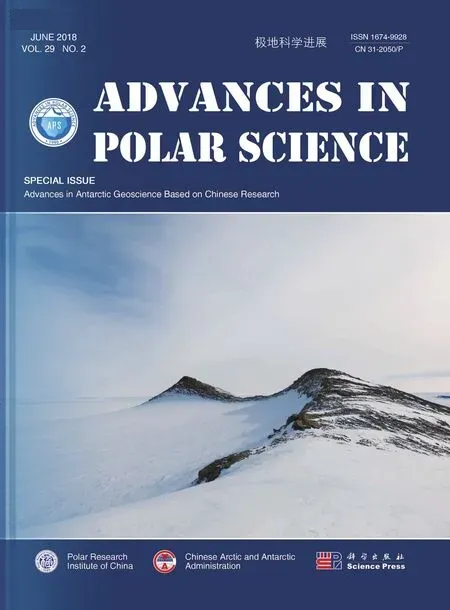Preliminary investigation of rubidium distribution in the Grove Mountains area, East Antarctica
2018-12-20LIYanHUANGFeixin
LI Yan & HUANG Feixin
Institute of Mineral Resources Research, China Metallurgical Geology Bureau, Beijing 101300, China
Abstract We analyzed rock samples from the Grove Mountains in Antarctica to determine the distribution of rubidium (Rb) in that location. We collected samples from the Black Nunataks, Melvoldt Nunataks, Mason Peaks, Zakharoff Ridge, Mount Harding, and the northern Gale Escarpment. Geochemical analysis indicated that in some samples the amount of Rb was higher than 300 ppm. This suggests that rocks from the Grove Mountains are rich in Rb. Based on field observations and previous research, we speculate that mica and potash feldspar from moyite, granite gneiss, and felsic pegmatite are the primary carrier minerals of Rb. However, further research is necessary to confirm this speculation.
Keywords Rb distribution, carrier minerals, Grove Mountains, East Antarctica
1 Introduction*
Rare metals, rare earth metals, and rare dissipated metals are the functional and structural materials described in the Chinese “Twelfth Five-Year Plan” as a means to initiate and develop strategic emerging industries in China (Sun et al.2013). Rubidium (Rb) is a metal used widely in military,science, and technological applications. The unique physical properties of Rb make it non-substitutable in many applications. Previously, Rb was used primarily in electronic components, catalysts, special forms of glass, and medicine. Now, however, it is gaining wider use in highly technical fields, such as thermal ion research,magnetohydrodynamic power generation, laser conversion of electric energy, and ion propulsion rocketry (Liu et al.,2015; Sun et al., 2013).
Previous research has shown that small deposits of Rb exist on all seven continents. Rb deposits are mainly found in Canada, United States, Zimbabwe, Namibia, Brazil,Mozambique, Russia, Germany, Portugal, France, Jordan,and Australia. However, there has been little research on the distribution of Rb in Antarctica. Supported by the Chinese Polar Environmental Comprehensive Investigation and Assessment Programs (known simply as the China Polar Program), we previously conducted a geochemical survey on the Grove Mountains area in Antarctica. We found Rb-rich rocks in the Grove Mountains and around the Zhongshan Station in the Larsemann Hills (Li et al., 2017a,2017b). The Rb content in some samples was up to 0.1%,suggesting the area maybe contain large Rb deposit.Because of the results of our previous study, we conducted a systematic sample analysis of the southeastern Grove Mountains area. This was done to investigate the distribution of Rb in the Grove Mountains. Our investigation of Rb deposits did not consider methods for the development of this resource, or any environmental protections that would be necessary before exploitation of the resource could begin.
2 Geographical location and geology of the Grove Mountains
The Grove Mountains are located on the right bank of the Lambert Rift in East Antarctica, between 72°20′–73°10′S and 73°50′–75°40′E. The Grove Mountains are part of the nunataks of the east Antarctic ice sheet, which are one of the most important geological features of the Prydz Belt.The Grove Mountains are an area in Antarctica where geological research has been conducted mainly by Chinese scientists (Liu et al., 2013; Liu et al., 2002).
The outcrops of high-grade metamorphic rocks in the Grove Mountains are primarily felsic orthogneiss, but also include small amounts of mafic granulite, paragneiss, and calcsilicate rock. The emplacement age of the protoliths of mafic granulite and orthogneiss is approximately 920–910 Ma, which was during the Grenville Orogenic period.The age of the zircon overgrowth is approximately 549―529 Ma, which indicates that the terrane in the Prydz Belt is a typical Pan-African metamorphic terrane (Wang et al., 2016a,2016b; Liu et al., 2013, 2007; Mikhalsky et al., 2001). The protoliths of paragneiss and calcsilicate rocks may be Mesoproterozoic sedimentary rocks. These rocks together form the pre-Pan-African basement of the Grove Mountains(Liu et al., 2013, 2006, 2003; Yu et al., 2002a, 2002b).Because of Pan-African metamorphic events, synorogenic or late orogenic granite, and the late orogenic granitic and granodioritic aplitic dyke, felsic pegmatites are widely distributed in this region (Liu et al., 2007; Liu et al., 2002).
Field observations and structural elements measurements revealed that the Grove Mountains underwent three periods of deformation. These deformations were northeast to southwest thrust in the earlier period (D1), northeast to southwest decoupling in the lower angle in the middle period (D2), and north-northeast semi-graben uplift of normal faults in the late period (D3) (Figure 1, Hu et al., 2008).
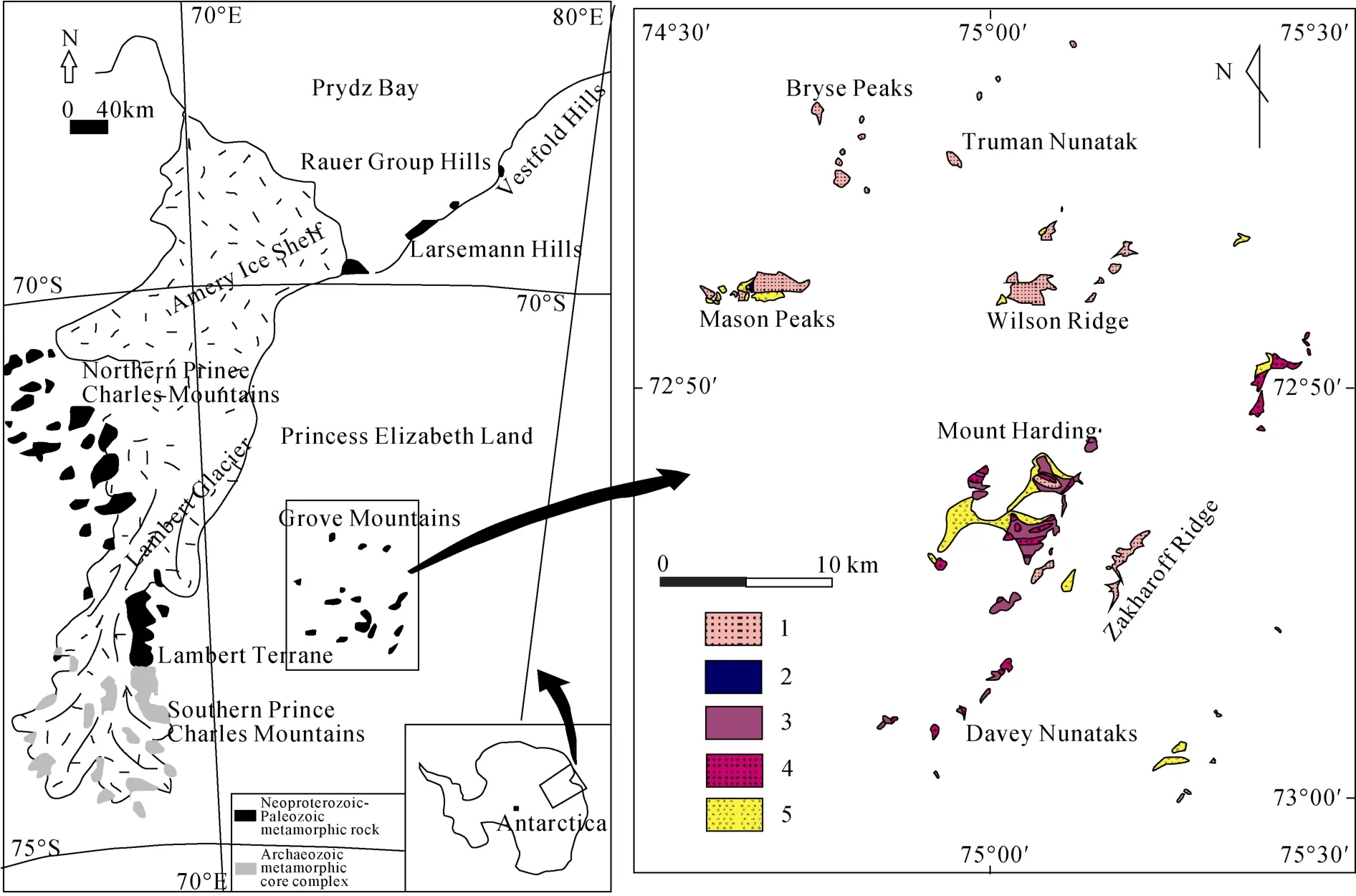
Figure 1 Geological sketch map of the Grove Mountains in East Antarctica (after Liu et al. (2009), Yu et al. (2002a, 2002b)). 1,Orthogneiss; 2, Mafic granulite; 3, Charnockite; 4, Granite; 5, Moraine.
3 Sample collection and test analysis
Samples were collected from the seventh Antarctic Grove Mountains Expedition (Figure 2). As allowed by the permitting conditions, we performed systematic sampling(mainly point sampling) on outcrops of the Grove Mountains (Figure 3). However, due to cold weather and other unforeseen difficulties, sampling work could not be done in some areas of the mountains. Sample tests were conducted in the Shandong Bureau Testing Center of the China Metallurgical Geology Bureau.
To perform our analysis we used an electronic balance(YQ008), ICE3500 atomic absorption spectrophotometer(YQ003), X Series2 inductively coupled plasma-mass spectrometer (YQ006), and IRIS Intrepid II XSP plasma emission spectrometer (YQ031). Our testing protocol followed the fourth edition of the “Rock Mineral Analysis”, published in 2011. Test data are shown in Table 1.
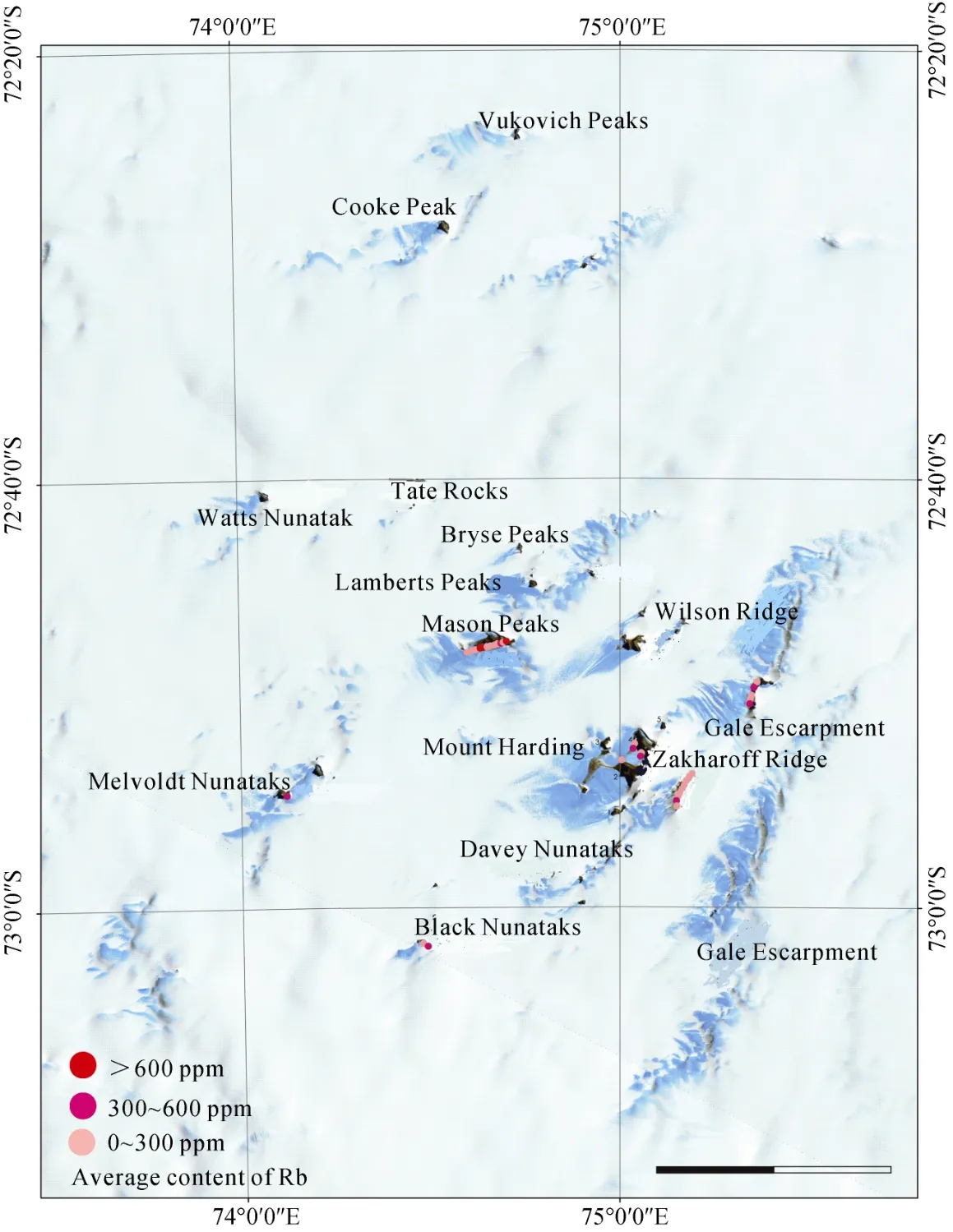
Figure 2 Sample location map of the Grove Mountains in East Antarctica.
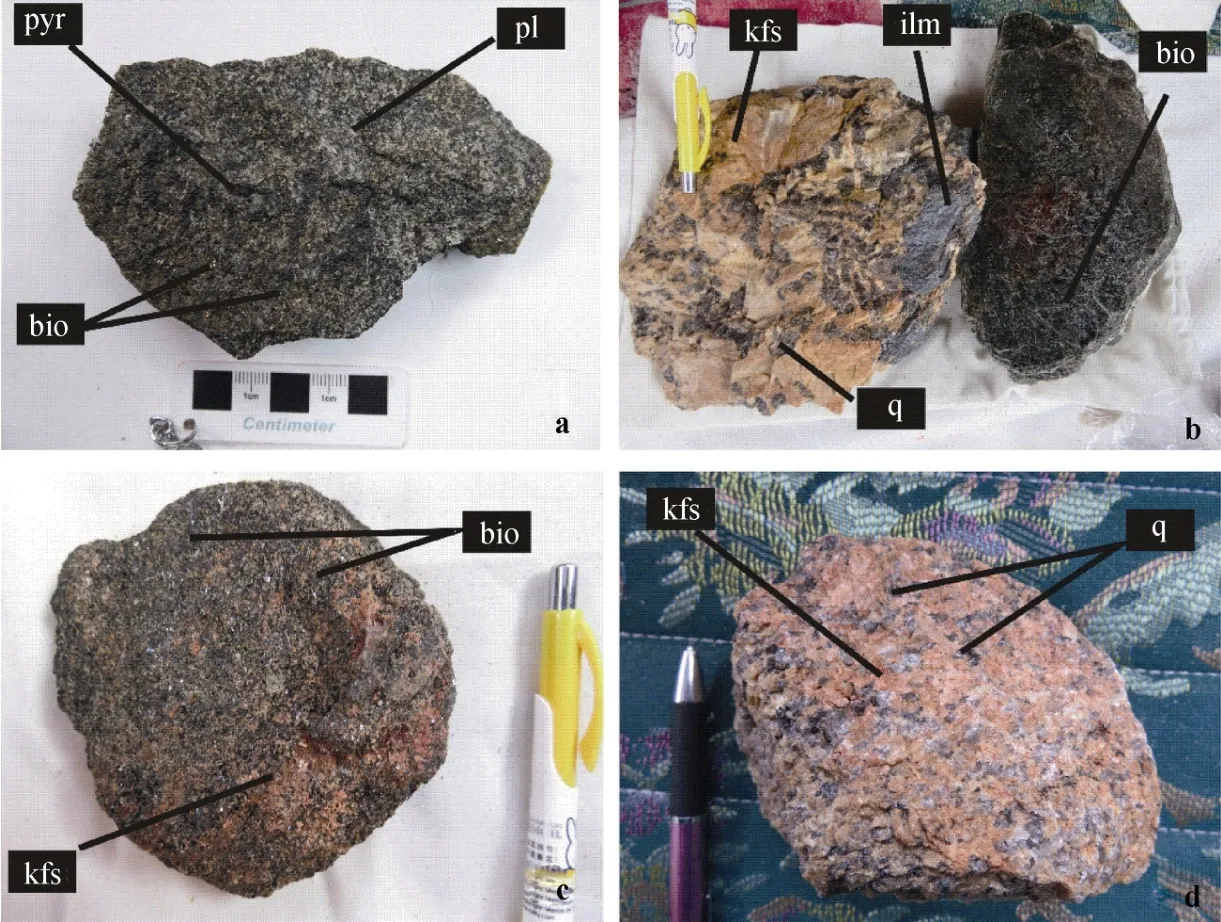
Figure 3 Photographs of samples taken from the Grove Mountains in East Antarctica. Samples are: a, granulite; b, pegmatite; c, granitic gneiss; d, moyite. Notes: bio–biotite; ilm–ilmenite; Kfs–K-feldspar; pl–plagioclase; pyr–pyroxene; q–quartz.
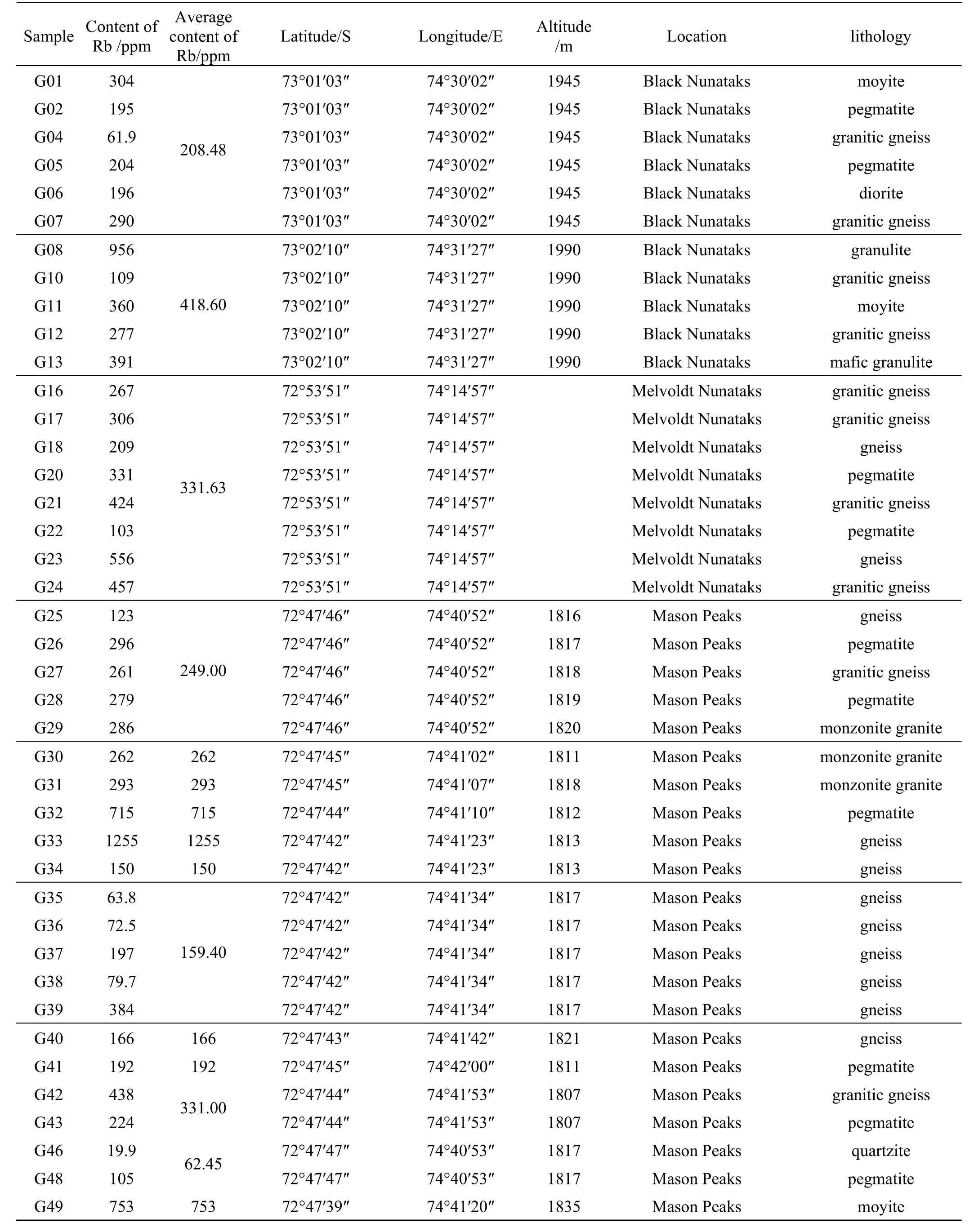
Table 1 Rubidium content of samples from the Grove Mountains in East Antarctica
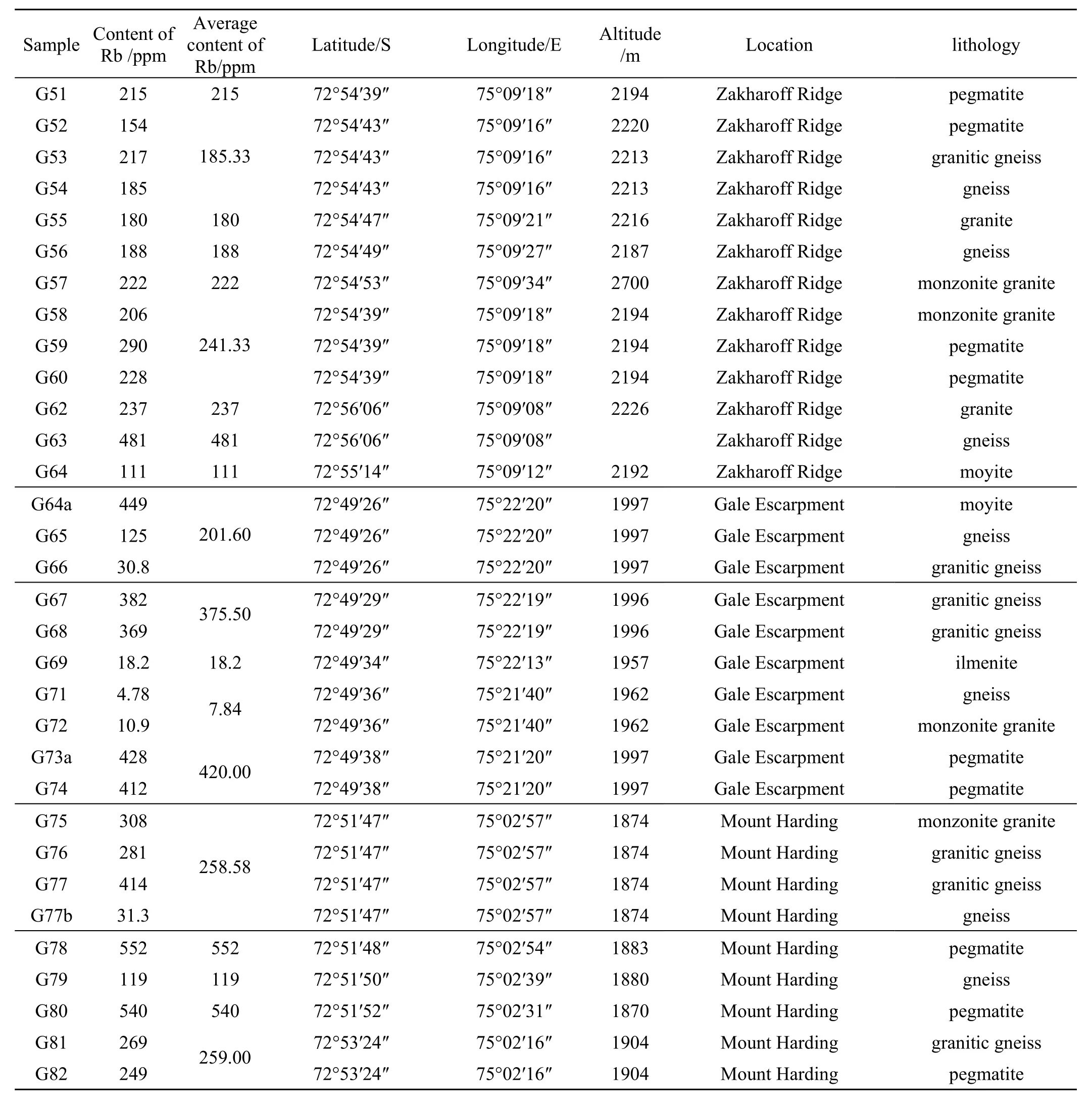
Continued
4 Results and discussion
There are 64 independent nunataks in the 320 km2of blue ice surface in the Grove Mountains. They are made up of five distinct islands of nunataks, distributed from the northeast to southwest. The nunataks illustrate the ridge and longitudinal valley geomorphology of the area. The relative height between the nunataks and the blue ice surface varies from 10 to 80 m. Because of the rising and scraping effects of ice cover movement from the southeast to the northwest,the snow-ice line is relatively high on the southeast side of the nunataks. Conversely, the northwest side of the nunataks usually show near-vertical fracture collapse.
Most of our samples came from the Black Nunataks,Melvoldt Nunataks, Mason Peaks, Zakharoff Ridge, Mount Harding, and the northern Gale Escarpment. We assumed that the average Rb content of samples from a particular location indicated the Rb content in that location. Figure 2 shows that every nunatak from which we had samples showed local Rb enrichment (Rb content up to 0.03%). This clearly suggests that rubidium is rich in this area of Antarctica.
Table 1 shows that the samples in this research were primarily granite, granitic gneiss, granitic pegmatite, mafic granulite, and diorite. Twenty-four of our samples contained Rb content above 0.03%. The samples with high Rb content were mainly granitic gneiss and pegmatite, but some samples were moyite and mafic granulite (Figure 2). There is no independent Rb mineral found in nature. Rb is usually found in K-rich silicate and chloride minerals in isomorphic forms, such as K-feldspar, muscovite, biotite, lepidolite,pollucite, and carnallite (Liu et al. 2015; Song et al. 2015).We used a Niton XL3t-500s Goldd analyzer on our rock samples in the field, and we found that the main carrier minerals of Rb were mica and K-feldspar. These minerals are often found with Rb. Further research, however, is needed to confirm this relationship.
5 Conclusions
We come to the conclusions below on basis of rubidium distribution in the Grove Mountains area, East Antarctica:
(1) Rubidium is relatively rich in the Grove Mountains,and the Rb content is very high in some locations.
(2) We found that Rb in the Grove Mountains was highest in moyite, granitic gneiss, and felsic pegmatite.Additionally, mica and K-feldspar may be the main carrier minerals of Rb. Further research, though, is needed to confirm this.
AcknowledgmentsThis study was funded by the Chinese Polar Environmental Comprehensive Investigation and Assessment Programs(Grant nos. CHINARE2016-02-05 and CHINARE2016-02-02). Our field investigation was supported by the Chinese Arctic and Antarctic Administration and Polar Research Institute of China. We wish to thank the seventh Grove Expedition team members for their help in the field sample collection process.
杂志排行
Advances in Polar Science的其它文章
- SHRIMP U-Pb zircon geochronology of granites from Sansom Island, Prydz Bay, East Antarctica
- Metamorphism and zircon U-Pb dating of high-pressure pelitic granulites from glacial moraines in the Grove Mountains, East Antarctica
- U-Th-Pb monazite and Sm-Nd dating of high-grade rocks from the Grove Mountains, East Antarctica: further evidence for a Pan-African-aged monometamorphic terrane
- Distribution domains of the Pan-African event in East Antarctica and adjacent areas
- Progress in Chinese Antarctic geodetic remote sensing
- Progress of Antarctic meteorite survey and research in China
